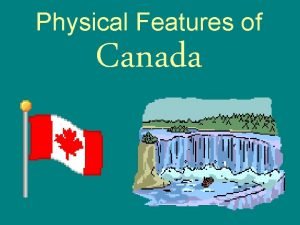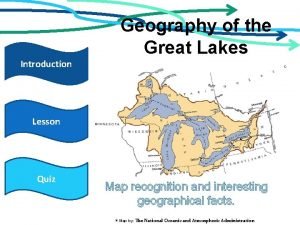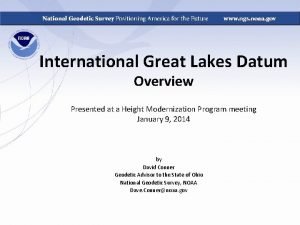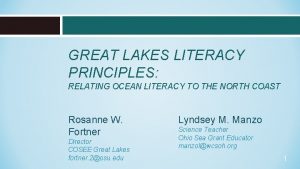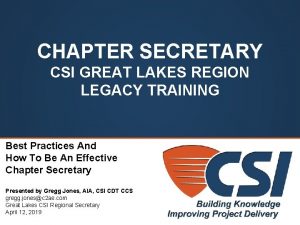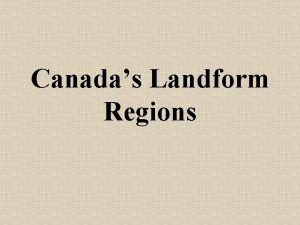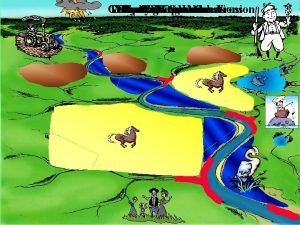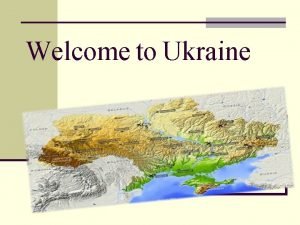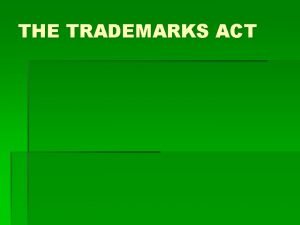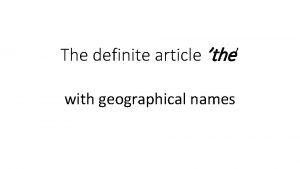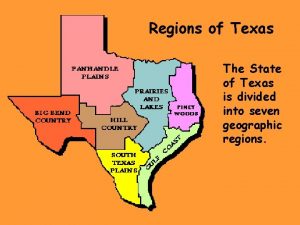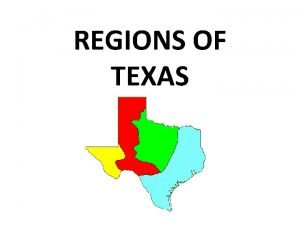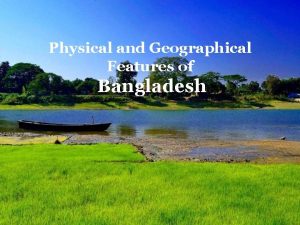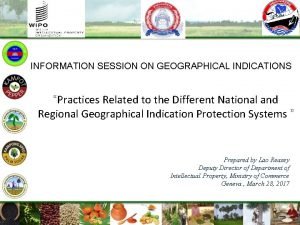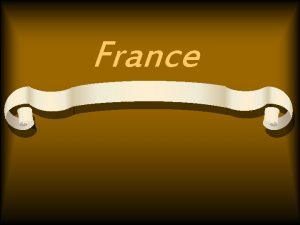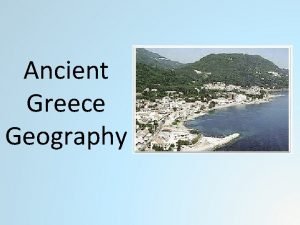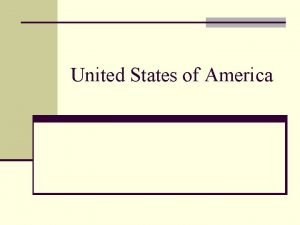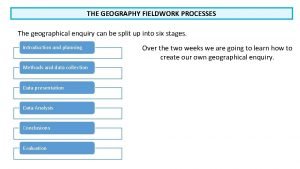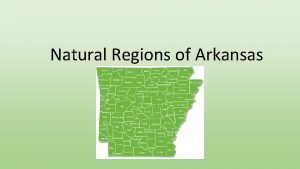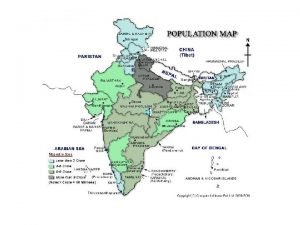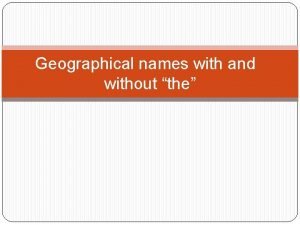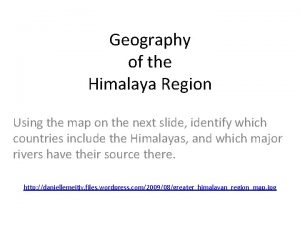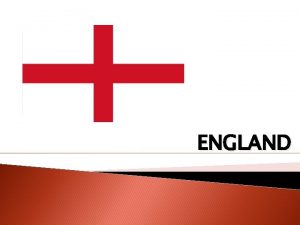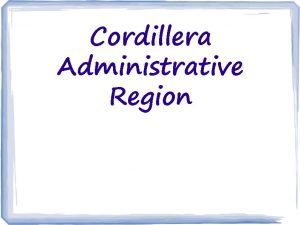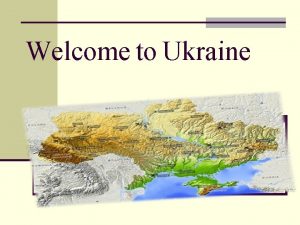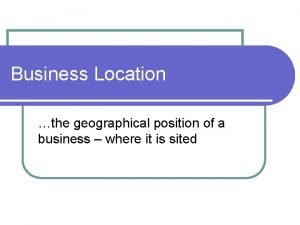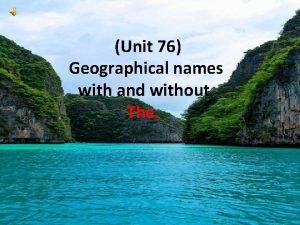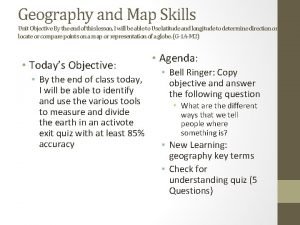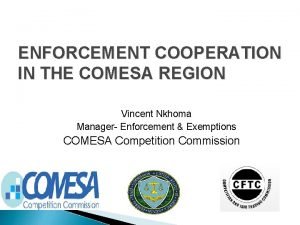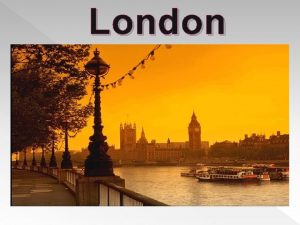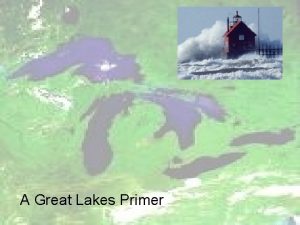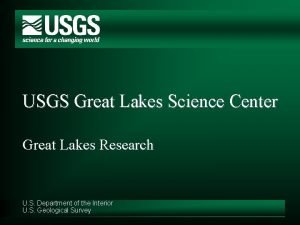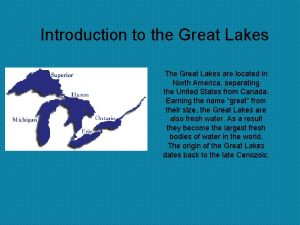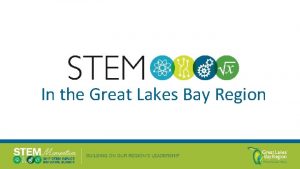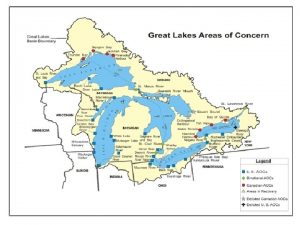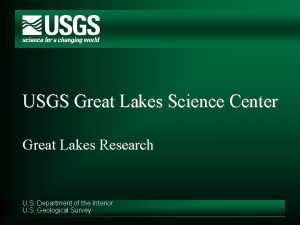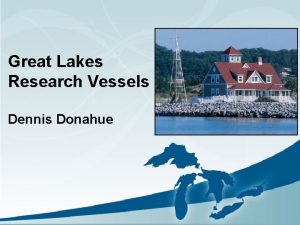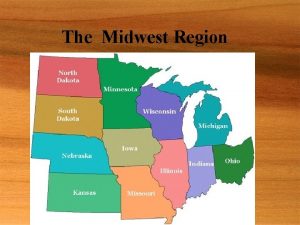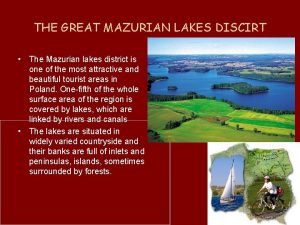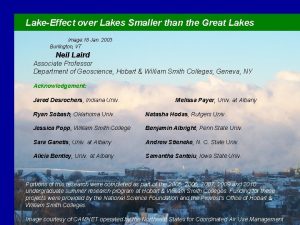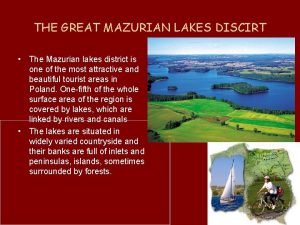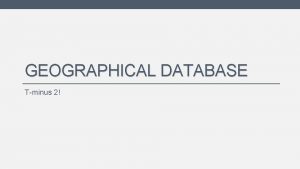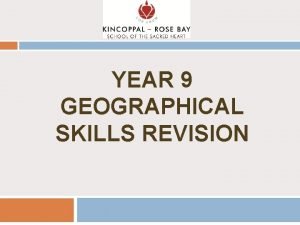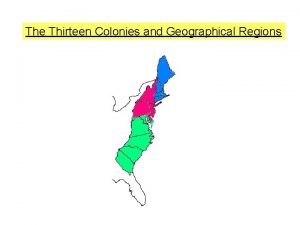The Great Lakes Geographical History The Great Lakes





































































- Slides: 69

The Great Lakes

Geographical History • The Great Lakes were formed during the last ice age, roughly 10, 000 years ago • The Glaciers carved the lakes out of an existing basin, and when the glaciers receded the meltwater filled up the holes. • The Great Lakes are generally considered to be the big 5, but many smaller lakes throughout the region are included in this massive basin, all tracing their beginnings back to the same source

Lake Ontario • Maximum Depth: 246 m (807 ft. ) • Average Depth: 86 m (283 ft. ) • Smallest surface area of all the Great Lakes • The only Great Lake that doesn’t touch the state of Michigan

Lake Erie • Max Depth: 62 m (203 ft. ) • Average Depth: 19 m (62 ft. ) • Shallowest and smallest volume of the Great Lakes • The Erie basin is the most densely populated and most developed of all the Great Lakes

Lake Huron • Max. Depth: 229 m (750 ft. ) Manitoulin • Average Depth: 195 ft. • Manitoulin Island, in the north of the lake is the world’s largest freshwater island.

Lake Superior • Max Depth: 406 m (1333 ft. ) • Average Depth: 147 m (482 ft. ) • Lake Superior has the largest surface area of any freshwater lake in the world. • It’s volume can fill all the other lakes, and have enough left over for three more Lake Erie’s!

Lake Michigan • Max. Depth: 281 m (925 ft. ) • Average Depth: 82 m (270 ft. ) • The only Great Lake exclusively within the United States • It is hydrologically inseparable from Lake Huron due to the wide Straits of Mackinaw

Great Lakes History • The Great Lakes have always been a major thoroughfare and trading route. • Natives have used the lakes and rivers in the Basin for thousands of years. • The first European ship on the lakes was the Frontenac, built by Sieur de la Salle. It was a 10 -ton vessel, likely a brigantine, and was lost on Lake Ontario in January 1679. • The first large European ship on the upper lakes was the Griffon, also built by de la Salle, in 1679 near modern Buffalo. It would have been roughly the size of Playfair or Pathfinder. The Griffon went missing in the fall of 1679, and no record or trace of it has been found

Conflict on the Lakes • The lakes were used for numerous naval engagements throughout the 17 th, 18 th and early 19 th century. • The British and French battled it out throughout the Great Lakes Basin until 1756, when the British defeated France at the Plains of Abraham and took control of all of North America.

Conflict on the Lakes • Within a few decades trouble was back with the American Revolution. • There were some minor naval battles during this time, but there were not substantial naval forces on the Lakes yet. • With the end of the conflict naval forces on the lakes were reduced and relative peace reigned.

War of 1812 • When the War of 1812 broke out there were numerous battles throughout the Great Lakes Basin. • The war eventually ended in stalemate, with little land having actually traded hands. • The Americans won almost every naval engagement though, both in the lakes and on the coasts.

War of 1812 • The War of 1812 brought conflict back to the Great Lakes. • By this time there was a much more considerable presence on both sides of the lakes. • The were many more battles, and the Great Lakes figured heavily in the conflict.

Important sites during the War of 1812 St. Joseph Island Drummond Island Mackinac Island (not the big island you see, a smaller island to the NW not shown on this map) Penentanguishene Kingston York (now Toronto) Straits of Mackinac Fort Niagara Fort George (Niagara-on-the-Lake) Detroit Erie, PA Ft. Dearborn (now Chicago) Amherstburg Put-in-Bay (Battle of Lake Erie) Rochester Oswego

Burning of York • The Americans came across Lake Ontario in April of 1813 with a fleet to capture York. They had 14 vessels and about 1800 soldiers. • The Americans arrived on the morning of the 26 th of April. York in 1804

Burning of York • The British only had about 350 soldiers at York. They retreated early on as they new they were seriously outnumbered. While leaving the British set fire to their magazine (gunpowder storage). • The ensuing explosion killed the American commander as well as 30 other Americans. Many more were wounded. • In retaliation the Americans plundered and burnt York over the 28 th to 30 th of April.

Battle of Lake Erie • • The culmination of the naval war on the Great Lakes was the Battle of Lake Erie, on September 10 th, 1813. The battle was fought in the west end of the lake, in and around the Bass Islands and Put-In-Bay Ohio.

Battle of Lake Erie • The British managed to seriously damage the American flagship Lawrence, at which point Commodore Perry transferred to the Niagara. • Despite this setback the Americans soundly won the battle, and it allowed them to retake Detroit, as well as command the lake for the rest of the war. Perry switching flagships

US Brig Niagara • The Niagara is a replica of a vessel that was present at the battle. • The replica is based out of Erie, PA.

HMS St. Lawrence • The only 3 -decker (first rate, or line-of-battle ship) on the Lakes. • Built in Kingston, launched 1814 • She was so powerful that her presence alone meant the American fleet never attempted to meet the British for battle on Lake Ontario. This meant she never actually saw action. • St. Lawrence II is named after her.

Lake Schooners The Denis Sullivan, a replica of a lake schooner that sails out of Wisconsin

Lake Schooners • The schooner quickly became the rig of choice in the Great Lakes due to their manoeuvrability and relatively smaller crew than a square-rigged vessel. • Most schooners still crossed a yard on the foremast so as to set a course and raffee when the wind was fair. • Centreboards were also very popular with lake schooners, the first vessel known to have had one was the Challenge, built in Wisconsin in 1852.

Lake Schooners • At one point there would have been thousands of schooners plying the lakes. • They would have ranged in size from 25 feet right up to over 250 ft. • The largest lakes schooner was the 275 foot David Dows.

Schooner David Dows

More Schooners Port Dalhousie Lucerne

• Trade under sail continued into the early 20 th century. • By the late 1800’s tugboats had been introduced, and most of the work in and out of ports was done with help. • Eventually sail was entirely replaced by power driven vessels that also had far larger cargo capacities.

Grand Haven Rig Unique to the Great Lakes, this is was a 3 -masted schooner rig with the Mainmast removed. This allowed for more cargo on deck, less sail to handle and they still sailed well!

Lake Freighters or “Lakers” ‘Straight-backer’ ‘Self-unloader’

Lakers • Lake freighters are long, straight and narrow. The conditions on the Lakes allow for this kind of construction due to smaller swells and waves. • The bow shape is also unique to the lakes. • Traditional Lakers also have their wheelhouses on the bow, as opposed to the stern. • The basic design traces back to the turn of the century.

Lakers • True Lakers are bulk carriers. They ship grain and iron ore for the most part, but can carry any bulk cargo. • If they have a self-unloading boom they are known as ‘Self-unloaders’. If they don’t then they are referred to as ‘straightbackers’.

Built in 1906 as SAMUEL MATHER this vessel was renamed PATHFINDER in 1925, and was subsequently known as GODERICH

J. A. W. Iglehart Built in 1935 as the Pan. Amoco • Dodged a torpedo attack in 1943 while on the East Coast • Still going strong!

Edmund Fitzgerald • Built in 1958 • Foundered in Lake Superior in 1975, she was lost with all hands and the exact cause continues to be a mystery.

What a nice looking boat!

More Lakers A self-unloader

Modernizing the fleet • Modern lakers, those built after the mid-1970’s roughly, are different from the older designs. • The wheelhouses have been moved aft, and the classic lines have been largely erased. • The bows have also been flattened. • These measures are mainly economical, resulting in cheaper and faster building. It also results in ships with much less aesthetic value.

The Algoisle, an example of a modern laker. (In the fall of 2009 Algoisle was retired. )

1, 000 Footers The largest vessels on the lakes are the “ 1, 000 footers”. They are called this as they are around (but usually over) 1, 000 feet long. They cannot use the Welland, and stay in the upper 4 lakes. Big! Bigger!

Captain Weed’s Favourite Freighter • 1, 004 feet long • 105 feet wide

Saltwater Vessels • Often you will see a salt-water vessel, known as a ‘saltie’ which has come up the Seaway from far away. • ‘Salties’ have much more flare to their bow and are generally under 600 ft.

Tugs and Barges • There are many tugboats and barges on the Great Lakes. • The barges carry anything and everything. • Tugboats are also used to help maneuver large vessels in port. Basically they are the ultimate workhorses.

Pathfinder? !? !? ! The other Pathfinder on the Lakes

• Combined with the tug Dorothy Anne, they make up an articulatedbarge unit.

Commercial Fishing • Fish tugs, sometimes known as ‘Turtle-backs’. Playfair II (She operates out of Killarney)

Commercial Fishing • The Americans have removed all of their commercial fishing industry on the Lakes, and now only have sport fishing from their ports. • The Canadian industry is quite large still. It is mainly focused in Lake Erie, with perch and whitefish being the main harvest.

The Windoc • The Windoc had a lift bridge dropped on her in the Welland Canal in 2001, subsequently while in Hamilton she broke free and washed ashore during a storm. • At this point she remains in Montreal where she has been since September 2002.

Welland Canal • There have been various different Welland Canal’s over the many years. • The first was built in the 1820’s

Later Canals • There have been four total, this picture is a lock from the Second Canal.

Present Canal • This is the fourth Canal, though a fifth was started and now is just known as the ‘Welland Bypass’ and is part of the current Canal

Present Canal • There are 8 locks between Port Weller on Lake Ontario, and Port Colborne on Lake Erie. The total height the canal lifts a ship is 99. 5 metres • Lock 8 is for adjustment to current water levels and the rise is typically only a few centimetres • The maximum dimensions for ships are: – 225. 5 m length – 8. 2 m draft – 35. 5 m air draft

Port Weller Port Colborne

St. Lawrence Seaway • There is a lock at Sault Ste. Marie (actually multiple locks, but only one lift) • There is a set of seven locks, similar in size to the Welland, between Montreal and Lake Ontario. • Together these make up the St. Lawrence Seaway. The Soo Locks

Great Lakes Weather

Great Lakes Weather • The Great Lakes are an area of complicated and rapidly changing weather patterns. • This is different from what is normally experienced in coastal and offshore sailing. • Systems move through quickly, and there are many variables resulting in challenging, and often severe weather.

General Weather • The weather is largely dictated by systems coming over from western North America. • The many different pressure grades and warm/cold fronts mean that the weather is constantly changing. • Combined with the heat storage of the Lakes, it makes for very interesting weather, and potential for very powerful, damaging windstorms.

A powerful squall in Green Bay, summer of 2006.

Wha’ Happen? • Playfair’s anchor with a bent shank after the squall passed. • This demonstrates the potential power of squalls on the lakes.

General Weather • Winds are stronger mid-lake • Waves and swell are larger the further downwind you get • Islands and shoreline will bend winds and waves around them, as well as slow them down • Due to their shape and layout there is a lot of funnelling of wind in the Great Lakes

Seiches • A Seiche is the “Free oscillation of water in a closed or semi-closed basin; frequently observed in harbours bays lakes and in almost any distinct basin of moderate size” • Basically sloshing back and forth on a very large scale. • This is typically started by a meteorological disturbance, such as sustained wind from one direction which dies out suddenly. • Longitudinal seiche period on Lake Ontario is about 5 hours, with a range of 0. 2 meters (<1 ft. ) • Longitudinal seiche period on Erie is about 14 hours, with a range of 2 m (6 ft. ) • In reality these are rarely at a magnitude that would be noticeable.

WATERSPOUTS!!! • Waterspouts are funnels extending from low cloud bases. They may encountered from late spring to early fall, and though short-lived they represent a real hazard to small craft.

Toronto • Established in 1793, as York

Toronto • Toronto quickly became a very important port due to its islands that created great natural shelter • Many schooners and then lakers operated out of Toronto • Up until the 1980’s Toronto’s waterfront was still mainly a commercial area – Now all that remains along the main shoreline are the grain silos and Redpath sugar

Toronto, 1894 Approximate location of the shop

Toronto Harbour, 1919 Sweet!

Toronto • Toronto continues to be a commercial port. • The city has a large sugar refinery as well as the container port in the Portlands. • A thriving industry of tour boats also helps keep Toronto’s waterfront alive and well, though the new development plans for the waterfront seem to forget that there are boats on the waterfront.

Environmental Concerns • Invasive species such as Zebra Mussels and Lampreys have become a large problem. • Zebra mussels rapidly clog water intakes, sewers outlets and cover boats. • Sea lampreys eat fish, cutting into stocks and hurting biodiversity. Sea Lampreys Zebra Mussels

Environmental Concerns • These invasive species and others are being managed as best as possible, but the ecosystem of the Great Lakes is in serous jeopardy.

Water Levels • Water levels also continue to be a problem in the Great Lakes. The mid-00’s saw some of the lowest waters on record (2006 was the worst), but there has been a slight recovery recently. Oliphant, Ontario. On Lake Huron

Water Levels • There is a debate about whether or not it is caused by a natural cycle or human interference. There may be some truth in both, but we all need to do what is possible to cut down on water usage.

“They're Grrreat!” And with 1/5 of the world’s freshwater contained on them, lets keep it that way.
 Great britain geographical position
Great britain geographical position Greatlakes scrip
Greatlakes scrip Great lakes depth comparison
Great lakes depth comparison States that border the great lakes
States that border the great lakes Acronoyms
Acronoyms Brenntag great lakes chicago
Brenntag great lakes chicago The great lakes quiz
The great lakes quiz International great lakes datum
International great lakes datum Greatlakesliteracy .net
Greatlakesliteracy .net Csi great lakes region
Csi great lakes region Great lakes labs
Great lakes labs Western cordillera landform region
Western cordillera landform region Great lakes on us map
Great lakes on us map 5 great lakes
5 great lakes The great lakes
The great lakes Great lakes institute of management
Great lakes institute of management Ukraine geographical position
Ukraine geographical position Can different species reproduce
Can different species reproduce Registration process of geographical indication
Registration process of geographical indication Registration of geographical indication
Registration of geographical indication Products of the southeast
Products of the southeast Nature of geographic data
Nature of geographic data Definite article with geographical names
Definite article with geographical names Geographical influence on architecture
Geographical influence on architecture 4 regions of texas map with cities and rivers
4 regions of texas map with cities and rivers North central plains economy
North central plains economy Geographical features of bangladesh
Geographical features of bangladesh Strategy and structure
Strategy and structure What are the 7 geographical concepts
What are the 7 geographical concepts Registration process of geographical indication
Registration process of geographical indication What is geographic isolation
What is geographic isolation France court system
France court system Greece geographical features
Greece geographical features Geographical map of ancient egypt
Geographical map of ancient egypt Potomac section ethnic groups
Potomac section ethnic groups Geographical position usa
Geographical position usa 6 stages of geography fieldwork
6 stages of geography fieldwork Geographical nouns
Geographical nouns 6 geographical regions of arkansas
6 geographical regions of arkansas Geographical position has given india
Geographical position has given india Geographical names with and without the
Geographical names with and without the Indications and appellations of origin
Indications and appellations of origin Mathematical location definition ap human geography
Mathematical location definition ap human geography Test articles with geographical names
Test articles with geographical names Australia geographical position
Australia geographical position Force behind management thought
Force behind management thought Geographical map of himalayas
Geographical map of himalayas What geographical feature usually distinguishes time zones
What geographical feature usually distinguishes time zones Types of geographical data
Types of geographical data Geographic events
Geographic events England geographical position
England geographical position Dangdang ay cordillera
Dangdang ay cordillera Isodemographic map definition
Isodemographic map definition Ukraine geographical position
Ukraine geographical position Geometrical
Geometrical Geographical position of a potential new business
Geographical position of a potential new business Essential skills to study geography
Essential skills to study geography Geographical enquiry
Geographical enquiry Geographical names with and without the
Geographical names with and without the Longitude and latitude map
Longitude and latitude map Geographical globalization
Geographical globalization Scalability techniques in distributed systems
Scalability techniques in distributed systems Geographical centre of london
Geographical centre of london Also history physical
Also history physical Hát kết hợp bộ gõ cơ thể
Hát kết hợp bộ gõ cơ thể Ng-html
Ng-html Bổ thể
Bổ thể Tỉ lệ cơ thể trẻ em
Tỉ lệ cơ thể trẻ em Chó sói
Chó sói Thang điểm glasgow
Thang điểm glasgow



